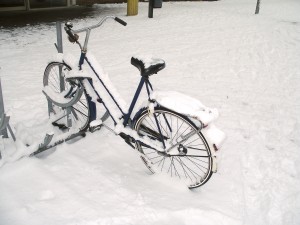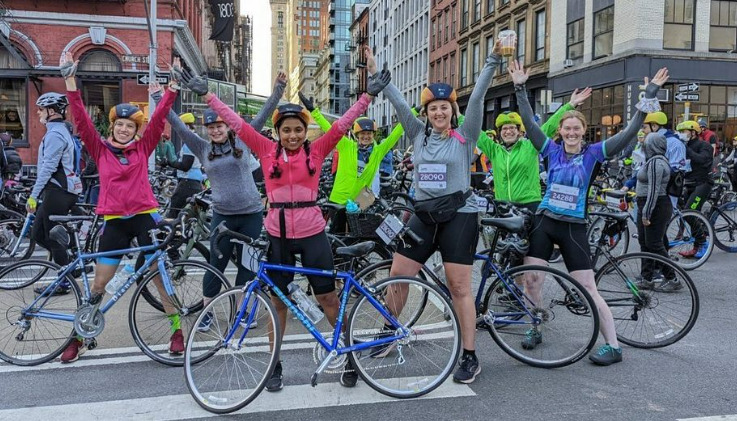
We have now entered daylight savings time, an official indicator that shorter days and colder temperatures are right around the corner. Bummed about putting your bike away just yet? Do you want to continue to ride as the weather gets colder but aren’t sure where to start? WE Bike NYC and Black Girls Do Bike presented a cold weather clinic in October with the main takeaways below. Special thanks to Casey Ashenhurst and Courtney Williams, spokeswomen of WE Bike NYC and Black Girls Do Bike: NYC, for organizing the clinic!
First Thing’s First – How to Dress?
For obvious reasons, wearing the right materials is the first step in staying warm, avoiding discomfort, or worse, danger such as hypothermia. Stay dry to stay warm!! The basic formula for cold weather dress is: moisture wicking layer + warm layer + wind/weatherproof layer. Moisture wicking fabric pulls moisture from the body to the exterior of the shirt where it can evaporate more easily, preventing body heat loss. Avoid cotton at all costs – instead turn to wool or synthetic fabrics. When determining outer layers, remember the difference in water-resistant (endures only a bit of water) versus waterproof (endures heavy precipitation). Windproof and weatherproof garments should be either breathable or vented to allow moisture from your bottom layers to escape and help with body temperature regulation.
Like most things bike-related, figuring out what combination works best is personal. Take some time to figure this out before a very cold day when you will be riding:
- Go for a ten minute ride in your combination of choice to see if it remains comfortable after your body heats up.
- If you step outside and are already warm, you probably want to take off on layer.
- As you experiment, take a backup layer with you to add on if necessary. Alternatively, carry a bag to hold any layers that need to come off.
- Try making a gear log of what worked best for you in different riding conditions to be better prepared.
- Don’t layer too heavily – you still want dexterity in your fingers and flexibility in limbs to shift gears and pedal.
Remember! Staying warm in the cold doesn’t mean you need to go buy all new gear! Work and experiment with what you already own, taking note of what essentials you need to invest in. Take mind of your extremities as these are generally the most susceptible parts of our bodies to suffer from the cold – use glove liners, full finger thermal gloves and/or lobster claw gloves to keep your fingers and hands warm and tall socks (preferably wool) and/or shoe covers for your toes and feet.
What about my Bike? How does it Operate Differently?
Winter in New York City is rough on bikes – the snow, and particularly the salt, take a toll on our bikes. Keep this in mind when deciding when and how often to ride as well as which bike you should ride if you have multiple. The salt on the roads is particularly corrosive to bicycle frames, so make sure to clean your bike more often during the winter to avoid maintenance issues.
Winter streets can be brutal – wetness, snow, and possible ice increase the chances of taking a spill. Lower the PSI in your tires to the suggested minimum PSI (this number can be found on your tire’s sidewall), as this helps increase surface area between tire and pavement. If you prefer, switch out your tires for winter tires. Clean your chain more often as the slush and dirt can cause seizing. When on the road, slow down – it’s hard to know what lays ahead on snowy, wet roads, so exercising caution is to your advantage. Brake earlier and avoid metal pieces of infrastructure as these become slippery. Use caution going over bridges as they become icy faster than the rest of the roads. If you are wondering what the road conditions are, check local bike forums for update. Most importantly, keep safety your number one priority!! No one likes a jam packed subway train, but if that is the safer option, there is no shame in taking the train.
Nutrition
It’s easy to think avoid drinking and eating properly in cold weather, but this is a mistake. Our bodies are burning more calories just to stay warm. Add the additional loss of calories from biking, and this translates into a greater need to replenish. Drinking cold water isn’t fun when it’s cold outside – try insulated water bottles and warm water. If you have any issues with the mouthpiece of your water bottle freezing shut, try tipping it upside down in its cage to prevent freezing.
Visibility
Now that we have fewer hours of daylight, the chances of you riding in the dark increases in cold weather. Now is a good time to check your lights and possibly invest in a few more. Keep an extra set of batteries in your pocket in case your lights go dim while out on the road. Reflective outerwear is also a good idea.
Alternative Training
If you prefer to avoid cold weather riding altogether, there are plenty of alternatives to not losing your endurance built up over the summer – join a gym, take spin classes, or get a bike trainer are just a few of the options cyclists have to maintain their endurance over the cold, dark winter.
Overall, remember to stay safe – if you are miserable on your bike in cold weather or unsure about your safety, there is no shame in finding another mode of transportation until you are able to bring your bike out again in the spring. Additional tips on cold weather riding can be found here.
